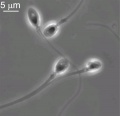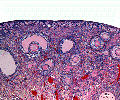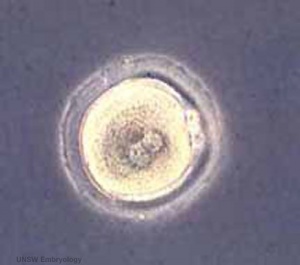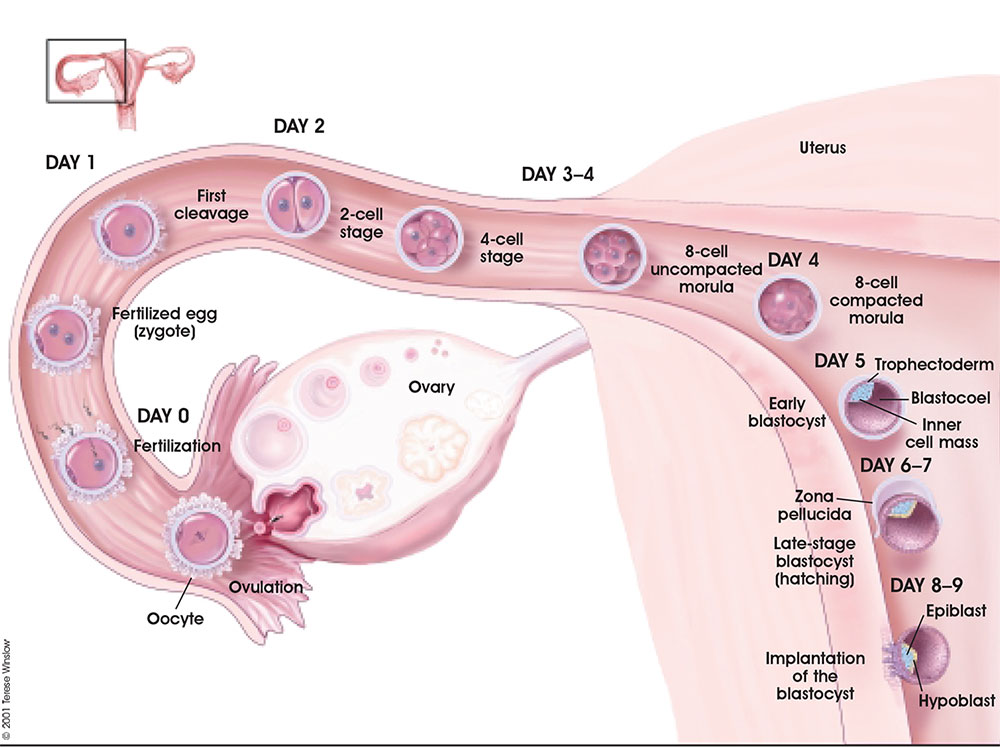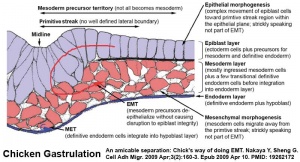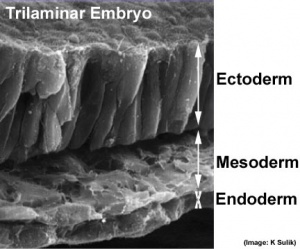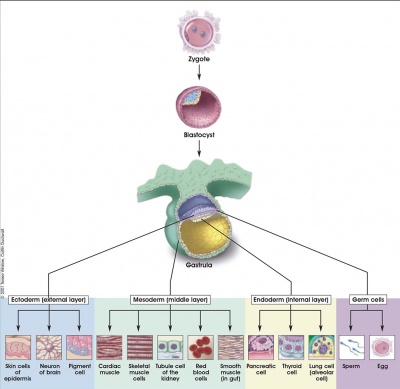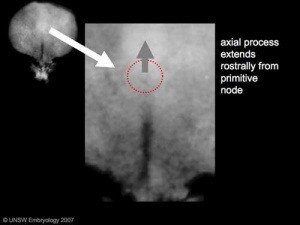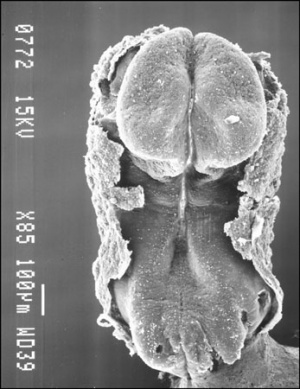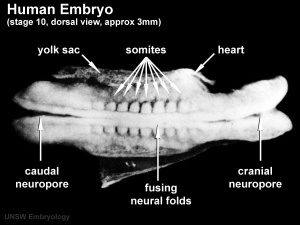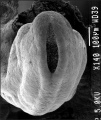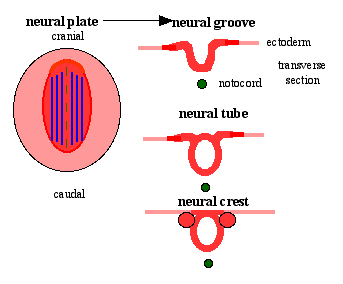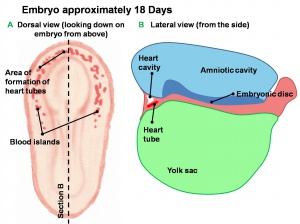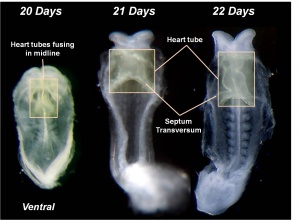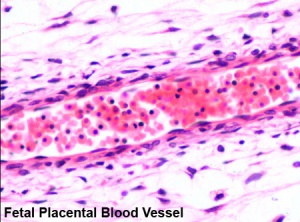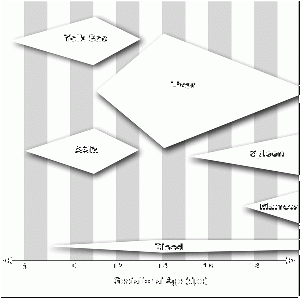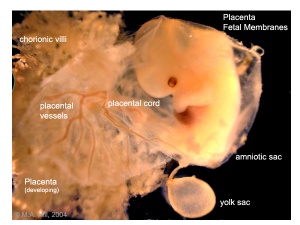2010 BGD Lecture - Development of the Embryo/Fetus 1: Difference between revisions
(→Male) |
m (Redirected page to BGDA Lecture - Development of the Embryo/Fetus 1) |
||
| (100 intermediate revisions by 2 users not shown) | |||
| Line 1: | Line 1: | ||
#REDIRECT [[BGDA Lecture - Development of the Embryo/Fetus 1]] | |||
[[File:BGDsmall.jpg|left]] | |||
==Introduction== | ==Introduction== | ||
* Begin by reviewing the recent Foundations [[2010 Foundations Lecture - Introduction to Human Development|Lecture]] and [[2010 Foundations Practical - Introduction to Human Development|Practical]]. | |||
* This lecture covers conceptus development from fertilization to implantation to trilaminar embryo formation. | |||
* The lecture will also introduce early fetal membranes and placentation. | |||
* [http://embryology.med.unsw.edu.au/Medicine/BGDlecture5.htm Previous 2008 Lecture] | |||
==Lecture Audio== | |||
{| border='0px' | |||
- | |- | ||
| [[File:Mark_Hill.jpg|60px|left]] | |||
| | |||
BGD Cycle A 2010 Audio - Dr Mark Hill Thursday 6th May 2010 10-11am Clancy Auditorium (This recording is not the UNSW Clancy iLecture, available elsewhere). | |||
* [[2010_BGD_Lecture_-_Development_of_the_Embryo/Fetus_1|lecture page]] | |||
* [[Media:BGD2010-EmbryoLecture01.mp3|listen]] | |||
* [[:File:BGD2010-EmbryoLecture01.mp3|download]] (6.6 Mb MP3 53:21) | |||
|- | |||
|} | |||
==Gametogenesis== | ==Gametogenesis== | ||
| Line 14: | Line 30: | ||
The testes have two functions. | The testes have two functions. | ||
# produce the male gametes or '''spermatozoa''' | # produce the male gametes or '''spermatozoa''' | ||
# produce male sexual hormone, '''testosterone''' (external genitalia, sex characteristics) | # produce male sexual hormone, '''testosterone''' (internal and external genitalia, sex characteristics) | ||
<gallery> | <gallery> | ||
File:Historic-testis.jpg|Historic testis drawing | File:Historic-testis.jpg|Historic testis drawing | ||
File:Seminiferous-tubule-HEx40.jpg|Adult Seminiferous tubule showing spermatozoa developmental stages | File:Seminiferous-tubule-HEx40.jpg|Adult Seminiferous tubule showing spermatozoa developmental stages | ||
File:Testis_histology_2.jpg|Seminiferous tubule cross-section and supporting cells | File:Testis_histology_2.jpg|Seminiferous tubule cross-section and supporting cells | ||
File:Human-spermatozoa.jpg|Human spermatozoa | |||
</gallery> | </gallery> | ||
* Spermatogonia - are the first cells of spermatogenesis | * [[S#spermatogonia|Spermatogonia]] - are the first cells of spermatogenesis | ||
* Primary spermatocytes - large, enter the prophase of the first meiotic division | * [[P#Primary spermatocyte|Primary spermatocytes]] - large, enter the prophase of the first meiotic division | ||
* Secondary spermatocytes - small, complete the second meiotic division | * [[S#secondary spermatocyte|Secondary spermatocytes]] - small, complete the second meiotic division | ||
* | * [[S#spermatid|Spermatid]] - immature spermatozoa | ||
* Spermatozoa - differentiated gamete | * [[S#spermatozoa|Spermatozoa]] - differentiated gamete | ||
::'''Spermatozoa development:''' [[P#primordial germ cell|primordial germ cell]] - [[S#spermatogonia|spermatogonia]] - [[P#primary spermatocyte|primary spermatocyte]] - [[S#secondary spermatocyte|secondary spermatocytes]] - [[S#spermatid|spermatid]] - [[S#spermatozoa|spermatozoa]] | |||
'''Sertoli cells''' (support cells) '''Interstitial cells''' or Leydig cells (produce hormone) | '''Sertoli cells''' (support cells) '''Interstitial cells''' or Leydig cells (produce hormone) | ||
| Line 32: | Line 51: | ||
The ovaries have two functions. | The ovaries have two functions. | ||
# produce the female gametes or '''oocytes''' | # produce the female gametes or '''oocytes''' | ||
# produce female hormones, estrogen and progesterone | # produce female hormones, [[E#estrogen|estrogen]] and [[P#progesterone|progesterone]] (secondary sex characteristics, menstrual cycle) | ||
<gallery> | <gallery> | ||
File:Ovary5x.gif|overview of ovary | File:Ovary5x.gif|overview of ovary | ||
| Line 39: | Line 58: | ||
File:Ova20he.jpg|secondary follicle | File:Ova20he.jpg|secondary follicle | ||
</gallery> | </gallery> | ||
::'''Ovarian Follicle Stages:''' [[P#primordial follicle|primordial follicle]] - [[P#primary_follicle|primary follicle]] - [[S#secondary_follicle|secondary follicle]] - [[T#tertiary_follicle|tertiary follicle]] - [[P#preovulatory_follicle|preovulatory follicle]] | |||
'''Follicle cells''' (support cells) '''Theca cells''' (produce hormone) | |||
'''Links:''' [http://www.ncbi.nlm.nih.gov/books/bv.fcgi?rid=mboc4.figgrp.3716 MBoC - Figure 20-18. Influence of Sry on gonad development] | [http://www.ncbi.nlm.nih.gov/bookshelf/br.fcgi?book=endocrin&part=A972&rendertype=box&id=A1230 Endocrinology - Comparative anatomy of male and female reproductive tracts] | |||
==Fertilization== | ==Fertilization== | ||
[[Image:Early zygote.jpg|thumb|Early zygote showing polar bodies]] | |||
* [[O#oogenesis|Oogenesis]] - 1 gamete produced/meiosis + 3 polar bodies, meiosis is slow, 1 egg produced and released at ovulation | |||
* [[S#spermatogenesis|Spermatogenesis]] - 4 gametes produced/meiosis, meiosis is fast, 200-600 million sperm released at ejaculation | |||
[[File:Ovulation_icon.jpg|90px|link=Movie_-_Ovulation 01]] [[File:Fertilization 001 icon.jpg|90px|link=Movie_-_Fertilization 01]] | |||
===Fertilization Site=== | |||
* Fertilization usually occurs in first 1/3 of uterine tube (oviduct, Fallopian tube) | |||
* Fertilization can also occur outside uterine tube associated with In Vitro Fertilization (IVF, GIFT, ZIFT...) and [[E#ectopic pregnancy|ectopic pregnancy]] | |||
* The majority of fertilized eggs do not go on to form an embryo | |||
===Fertilization - Spermatozoa === | |||
* '''Sperm Binding''' - [[Z#zona pellucida|zona pellucida]] protein ZP3 acts as receptor for sperm | |||
*[[A#acrosome reaction|Acrosome Reaction]] - exyocytosis of acrosome contents (Calcium mediated) [http://www.ncbi.nlm.nih.gov/books/bv.fcgi?rid=mboc4.figgrp.3741 MBoC - Figure 20-31. The acrosome reaction that occurs when a mammalian sperm fertilizes an egg] | |||
** enzymes to digest the zona pellucida | |||
** exposes sperm surface proteins to bind ZP2 | |||
* '''Membrane Fusion''' - between sperm and egg, allows sperm nuclei passage into egg cytoplasm | |||
===Fertilization - Oocyte=== | |||
* '''Membrane Depolarization''' - caused by sperm membrane fusion, primary block to polyspermy | |||
* [[C#cortical reaction|Cortical Reaction]] - IP3 pathway elevates intracellular Calcium, exocytosis of cortical granules [http://www.ncbi.nlm.nih.gov/books/bv.fcgi?rid=mboc4.figgrp.3743 MBoC - Figure 20-32. How the cortical reaction in a mouse egg is thought to prevent additional sperm from entering the egg] | |||
** enzyme alters ZP3 so it will no longer bind sperm plasma membrane | |||
* '''Meiosis 2''' - completion of 2nd meiotic division | |||
** forms second polar body (a third polar body may be formed by meiotic division of the first polar body) | |||
[[File:Embryo_mitosis_icon.jpg|90px|link=Movie_-_Embryo_Mitosis]] [[File:Week1 001 icon.jpg|90px|link=Development_Animation_-_Week_1]] | |||
==Week 1 and 2== | ==Week 1 and 2== | ||
| Line 47: | Line 100: | ||
===Week 2 Implantation=== | ===Week 2 Implantation=== | ||
[[File:Week2_001 icon.jpg|90px|link=Development_Animation_-_Implantation]] | [[File:Week2_001 icon.jpg|90px|link=Development_Animation_-_Implantation]] [[File:Chorion 001 icon.jpg|90px|link=Development Animation - Chorionic Cavity]] | ||
==Week 3 Gastrulation== | ==Week 3 Gastrulation== | ||
| Line 54: | Line 106: | ||
[[File:Trilaminar_embryo.jpg|thumb|Trilaminar embryo SEM]] | [[File:Trilaminar_embryo.jpg|thumb|Trilaminar embryo SEM]] | ||
Gastrulation, (Greek = belly) means the formation of gut, but has been used in a more looser sense to to describe the formation of the trilaminar embryo. The [[E#epiblast|epiblast layer]], consisting of totipotential cells, derives all 3 embryo layers:[[E#endoderm|endoderm]], [[M#mesoderm|mesoderm]] and [[E#ectoderm|ectoderm]]. The [[P#primitive streak|primitive streak]] is the visible feature which represents the site of cell migration to form the additional layers. Historically, gastrulation was one of the earliest observable morphological event occurring in the frog embryo. | |||
[[ | * [[P#primitive node|primitive node]] - region in the middle of the early embryonic disc epiblast from which the primitive streak extends caudally (tail) | ||
** nodal cilia establish the embryo left/right axis | ** nodal cilia establish the embryo left/right axis | ||
** axial process extends from the nodal epiblast | ** axial process extends from the nodal epiblast | ||
* | * [[P#primitive streak|primitive streak]] - region of cell migration from the epiblast layer forming sequentially the two germ cell layers (endoderm and mesoderm) | ||
[[File:Trilaminar_embryo_cartoon.jpg|400px|Trilaminar embryo]] | |||
[[File:Mesoderm 001 icon.jpg|90px|link=Development_Animation_-_Mesoderm]] | [[File:Mesoderm 001 icon.jpg|90px|link=Development_Animation_-_Mesoderm]] | ||
== Notochord == | == Notochord == | ||
[[Image:Stage7 axial process.jpg|thumb|Stage7 axial process]] | [[Image:Stage7 axial process.jpg|thumb|Stage7 axial process]] | ||
The notochord is a structure which has an early mechanical role in embryonic disc folding and a major signaling role in patterning surrounding embryonic tissue development. This signaling role patterns many different tissues (neural plate, neural tube, somites, endodermal organs). It has its own sequence of development from a primitive axial process and is a developmental feature not present in the adult anatomy. | |||
The [[N#notochord|notochord]] is a structure which has an early mechanical role in embryonic disc folding and a major signaling role in patterning surrounding embryonic tissue development. This signaling role patterns many different tissues ([[N#neural plate|neural plate]], [[N#neural tube|neural tube]], [[S#somite|somites]], endodermal organs). It has its own sequence of development from a primitive axial process and is a developmental feature not present in the adult anatomy. | |||
[http://embryology.med.unsw.edu.au/Movies/larsen/notoch.mov Movie - notochord 1] [http://embryology.med.unsw.edu.au/Movies/larsen/noto.mov Movie - notochord 2] | |||
* '''axial process''' an initial epiblast hollow epithelial tube which extends in the midline from the primitive pit, cranially in the embryonic disc (toward the oral membrane). | * '''axial process''' an initial epiblast hollow epithelial tube which extends in the midline from the primitive pit, cranially in the embryonic disc (toward the oral membrane). | ||
** '''neuroenteric canal''' is a transient communication between the amnionic cavity and the yolk sac cavity formed by the axial process. | ** '''neuroenteric canal''' is a transient communication between the amnionic cavity and the yolk sac cavity formed by the axial process. | ||
| Line 77: | Line 131: | ||
==Somitogenesis== | ==Somitogenesis== | ||
[[File:Stage_9_SEM1.jpg|thumb|stage 9 Embryo]] [[File:Stage10 bf6b.jpg|thumb|stage 10 Embryo]] | [[File:Stage_9_SEM1.jpg|thumb|stage 9 Embryo]] [[File:Stage10 bf6b.jpg|thumb|stage 10 Embryo]] | ||
'''Mesoderm''' means the "middle layer" and it is from this layer that nearly all the bodies connective tissues are derived. In early mesoderm development a number of transient structures will form and then be lost as tissue structure is patterned and organised. Humans are vertebrates, with a "backbone", and the first mesoderm structure we will see form after the notochord will be '''somites'''. | '''Mesoderm''' means the "middle layer" and it is from this layer that nearly all the bodies connective tissues are derived. In early mesoderm development a number of transient structures will form and then be lost as tissue structure is patterned and organised. Humans are vertebrates, with a "backbone", and the first mesoderm structure we will see form after the notochord will be '''[[S#somite|somites]]'''. | ||
'''Coelom''', meaning "cavity", and major fluid-filled cavities can be seen to form both within the embryo (intraembryonic coelom) and outside the embryo (extraembryonic coelom). The '''intraembryonic coelom''' is the single primitive cavity that lies within the mesoderm layer that will eventually form the 3 major anatomical body cavities ('''pericardial, pleural, peritoneal'''). | '''Coelom''', meaning "cavity", and major fluid-filled cavities can be seen to form both within the embryo ([[I#intraembryonic coelom|intraembryonic coelom]]) and outside the embryo (extraembryonic coelom). The '''intraembryonic coelom''' is the single primitive cavity that lies within the mesoderm layer that will eventually form the 3 major anatomical body cavities ('''[[P#pericardial cavity|pericardial]], [[P#pleural cavity|pleural]], [[P#peritoneal cavity|peritoneal]]'''). | ||
<gallery> | <gallery> | ||
| Line 88: | Line 142: | ||
</gallery> | </gallery> | ||
[[File:Stage11 | [[File:Stage11 sem100c.jpg||thumb|stage 11 Embryo]] | ||
Somite initially forms 2 main components | Somite initially forms 2 main components | ||
| Line 106: | Line 160: | ||
==Week 4 Neuralation== | ==Week 4 Neuralation== | ||
<gallery> | <gallery> | ||
File:Stage10_SEM1.jpg|Stage 10 | File:Stage10_SEM1.jpg|[[Carnegie_stage_10|Stage 10]] (22 - 23 days) | ||
File:Stage10_sem2.jpg|Stage 10 | File:Stage10_sem2.jpg|[[Carnegie_stage_10|Stage 10]] (22 - 23 days) | ||
File: | File:Stage11_sem6.jpg|[[Carnegie_stage_11|Stage 11]] (23 - 26 days) | ||
File:Stage12_SEM3.jpg|Stage | File:Stage12_SEM3.jpg|[[Carnegie_stage_12|Stage 12]] (26 - 30 days) | ||
</gallery> | </gallery> | ||
Ectoderm - 2 parts | Ectoderm - 2 parts | ||
* midline neural plate | * midline [[N#neural plate|neural plate]] (columnar cells) | ||
* lateral surface ectoderm (cuboidal cells) | |||
* lateral surface ectoderm | ** sensory [[P#placode|placodes]] | ||
** sensory placodes | |||
** epidermis of skin, hair, glands, anterior pituitary, teeth enamel | ** epidermis of skin, hair, glands, anterior pituitary, teeth enamel | ||
===Neural Plate=== | ===Neural Plate=== | ||
[[File:Neural tube defect meningomyelocele.jpg|thumb|meningomyelocele]] | |||
[[Image:Neural_plate_movie_icon.jpg]][[Image:Neuralplate cartoon.png]] | [[Image:Neural_plate_movie_icon.jpg]][[Image:Neuralplate cartoon.png]] | ||
* extends from [[B#buccopharyngeal membrane|buccopharyngeal membrane]] to [[P#primitive node|primitive node]] | |||
* extends from buccopharyngeal membrane to primitive node | * forms above [[N#notochord|notochord]] and [[P#paraxial mesoderm|paraxial mesoderm]] | ||
* forms above notochord and paraxial mesoderm | |||
* neuroectodermal cells | * neuroectodermal cells | ||
** broad brain plate | ** broad brain plate | ||
** narrower spinal cord | ** narrower spinal cord | ||
* 3 components form: floor plate, neural plate, neural crest | * 3 components form: [[F#floor plate|floor plate]], [[N#neural plate|neural plate]], [[N#neural crest|neural crest]] | ||
[[File:Neuralplate_001 icon.jpg|90px|link=Development Animation - Neural Plate]] [[File:Neuraltube_001 icon.jpg|90px|link=Development Animation - Neural Tube]] | |||
==Cardiogenesis== | ==Cardiogenesis== | ||
[[File:Early_Development_of_Heart_Tube.jpg|thumb|Early Development of Heart Tube]] | |||
[[File:Human heart SEM1.jpg]] | [[File:Human heart SEM1.jpg]] | ||
[[File:Heart_Tube_Fusion.jpg|thumb|Heart Tube Fusion]] | |||
The Human Heart from day 10 to 25 (scanning electron micrograph) | The Human Heart from day 10 to 25 (scanning electron micrograph) | ||
| Line 141: | Line 195: | ||
* week 3 begins as paired heart tubes that fuse to form single heart tube | * week 3 begins as paired heart tubes that fuse to form single heart tube | ||
* begins to beat in Humans- day 22-23 | * begins to beat in Humans- day 22-23 | ||
[[File:Week3_folding icon.jpg|120px|right|link=Development Animation - Week 3]] | |||
===Blood Islands=== | ===Blood Islands=== | ||
[[File:Placenta blood.jpg|thumb|fetal blood]] | [[File:Placenta blood.jpg|thumb|fetal blood]] | ||
* 2 populations of cells | * 2 populations of cells | ||
** peripheral- form endothelial cells | ** peripheral- form [[E#endothelium|endothelial cells]] that form the lining of all blood vessels | ||
** core- form blood cells (haemocytoblasts) | ** core- form blood cells ([[H#haemocytoblast|haemocytoblasts]]) | ||
* all vessels (arteries and veins) appear initially the same | * all vessels (arteries and veins) appear initially the same | ||
===Blood Formation=== | ===Blood Formation=== | ||
[[File:Mouse hematopoietic stem cell.gif|thumb|Mouse hematopoietic stem cell location]] | [[File:Mouse hematopoietic stem cell.gif|thumb|Mouse hematopoietic stem cell location]] | ||
* blood formation from stem cells occurs initially in the extraembryonic mesoderm of the yolk sac | * blood formation from stem cells occurs initially in the [[E#extraembryonic mesoderm|extraembryonic mesoderm]] of the [[Y#yolk sac|yolk sac]] | ||
* then later (week 5) throughout embryonic mesenchyme | * then later (week 5) throughout embryonic mesenchyme | ||
* blood stem cells then migrate into the liver | * blood stem cells then migrate into the liver | ||
| Line 157: | Line 213: | ||
===Red Blood Cells=== | ===Red Blood Cells=== | ||
The only cells in the blood are nearly entirely fetal red blood cells. These cells differ from adult red blood cells in: | The only cells in the blood are nearly entirely fetal red blood cells (RBC). | ||
These red blood cells differ from adult red blood cells in: | |||
* often remaining nucleated | * often remaining nucleated | ||
* contain fetal haemoglobin - | * contain [[F#fetal haemoglobin|fetal haemoglobin]] - has different oxygen and carbon dioxide binding characteristics | ||
==Early Placentation== | ==Early Placentation== | ||
[[File:Week2_001 icon.jpg|90px|link=Development_Animation_-_Implantation]] | |||
[[File:Placental_membranes.jpg|thumb|Placenta and placental membranes]] | [[File:Placental_membranes.jpg|thumb|Placenta and placental membranes]] | ||
[[File:Placenta_anchoring_villi.jpg|thumb|Placenta anchoring villi]] | [[File:Placenta_anchoring_villi.jpg|thumb|Placenta anchoring villi]] | ||
The trophoblast layer has now differentiated into two morphologically distinct cellular layers. | The trophoblast layer has now differentiated into two morphologically distinct cellular layers. | ||
*'''Syncitiotrophoblasts''' - form a multinucleated cytoplasmic mass by cytotrophoblast cell fusion and both invade the decidua and secrete hCG | *'''[[S#syncitiotrophoblast|Syncitiotrophoblasts]]''' - form a multinucleated cytoplasmic mass by cytotrophoblast cell fusion and both invade the [[D#decidua|decidua]] and secrete [[H#hCG|hCG]] | ||
*'''Cytotrophoblasts''' - form a cellular layer around the blastocyst, proliferates and extends behind syncitiotrophoblasts | *'''[[C#cytotrophoblast|Cytotrophoblasts]]''' - form a cellular layer around the [[B#blastocyst|blastocyst]], proliferates and extends behind syncitiotrophoblasts | ||
Early Utero-Placental exchange - transfer of nutrition from maternal lacunae filled with secretions from uterine glands and maternal blood from blood vessels. | Early Utero-Placental exchange - transfer of nutrition from maternal lacunae filled with secretions from [[U#uterine gland|uterine glands]] and maternal blood from blood vessels. | ||
The development of trophoblast villi extending into the uterine decidua. | The development of trophoblast villi extending into the uterine decidua. | ||
There are three stages of villi development: | There are three stages of villi development: | ||
# '''Primary Villi''' - [[C#cytotrophoblast|cytotrophoblast]] | |||
# '''Secondary Villi''' - [[C#cytotrophoblast|cytotrophoblast]] + [[E#extraembryonic mesoderm|extraembryonic mesoderm]] | |||
# '''Tertiary Villi''' - [[C#cytotrophoblast|cytotrophoblast]] + [[E#extraembryonic mesoderm|extraembryonic mesoderm]] + blood vessels | |||
<gallery> | |||
File:Gray0036.gif|Primary chorionic villi | |||
File:Gray0037.gif|Tertiary chorionic villi | |||
File:Placenta anchoring villi.jpg|Placenta anchoring villi | |||
</gallery> | |||
There are two main types of early villi: | There are two main types of early villi: | ||
* Anchoring villi - attached to decidua | * Anchoring villi - attached to [[D#decidua|decidua]] | ||
* Floating villi - not attached to decidua, floating in maternal lacunae. | * Floating villi - not attached to [[D#decidua|decidua]], floating in maternal [[L#lacunae|lacunae]]. | ||
==Additional Reading== | |||
The following material is not part of todays lecture, these are 2009 science lectures and other resources that relate to the concepts covered in much more detail. [[Cardiac Embryology]] was a 2009 medical student ILP embryology education project completed in my laboratory. | |||
[[2009 Lecture 2|Cell Division/Fertilization]] | [[2009 Lecture 3|Week 1&2 Development]] | [[2009 Lecture 4|Week 3 Development]] | [[2009 Lecture 5|Mesoderm Development]] | [[2009 Lecture 6|Ectoderm, Early Neural, Neural Crest]] | [[2009 Lecture 7|Early Vascular Development]] | [[2009 Lecture 8|Placenta]] | [[Cardiac Embryology]] | [[Flash_Movies|Movies]] | |||
{{Template:BGDFooter2010}} | {{Template:BGDFooter2010}} | ||
Latest revision as of 08:56, 18 September 2014
Redirect to:
Introduction
- Begin by reviewing the recent Foundations Lecture and Practical.
- This lecture covers conceptus development from fertilization to implantation to trilaminar embryo formation.
- The lecture will also introduce early fetal membranes and placentation.
- Previous 2008 Lecture
Lecture Audio
|
BGD Cycle A 2010 Audio - Dr Mark Hill Thursday 6th May 2010 10-11am Clancy Auditorium (This recording is not the UNSW Clancy iLecture, available elsewhere).
|
Gametogenesis
Male
The testes have two functions.
- produce the male gametes or spermatozoa
- produce male sexual hormone, testosterone (internal and external genitalia, sex characteristics)
- Spermatogonia - are the first cells of spermatogenesis
- Primary spermatocytes - large, enter the prophase of the first meiotic division
- Secondary spermatocytes - small, complete the second meiotic division
- Spermatid - immature spermatozoa
- Spermatozoa - differentiated gamete
- Spermatozoa development: primordial germ cell - spermatogonia - primary spermatocyte - secondary spermatocytes - spermatid - spermatozoa
Sertoli cells (support cells) Interstitial cells or Leydig cells (produce hormone)
Female
The ovaries have two functions.
- produce the female gametes or oocytes
- produce female hormones, estrogen and progesterone (secondary sex characteristics, menstrual cycle)
- Ovarian Follicle Stages: primordial follicle - primary follicle - secondary follicle - tertiary follicle - preovulatory follicle
Follicle cells (support cells) Theca cells (produce hormone)
Links: MBoC - Figure 20-18. Influence of Sry on gonad development | Endocrinology - Comparative anatomy of male and female reproductive tracts
Fertilization
- Oogenesis - 1 gamete produced/meiosis + 3 polar bodies, meiosis is slow, 1 egg produced and released at ovulation
- Spermatogenesis - 4 gametes produced/meiosis, meiosis is fast, 200-600 million sperm released at ejaculation
Fertilization Site
- Fertilization usually occurs in first 1/3 of uterine tube (oviduct, Fallopian tube)
- Fertilization can also occur outside uterine tube associated with In Vitro Fertilization (IVF, GIFT, ZIFT...) and ectopic pregnancy
- The majority of fertilized eggs do not go on to form an embryo
Fertilization - Spermatozoa
- Sperm Binding - zona pellucida protein ZP3 acts as receptor for sperm
- Acrosome Reaction - exyocytosis of acrosome contents (Calcium mediated) MBoC - Figure 20-31. The acrosome reaction that occurs when a mammalian sperm fertilizes an egg
- enzymes to digest the zona pellucida
- exposes sperm surface proteins to bind ZP2
- Membrane Fusion - between sperm and egg, allows sperm nuclei passage into egg cytoplasm
Fertilization - Oocyte
- Membrane Depolarization - caused by sperm membrane fusion, primary block to polyspermy
- Cortical Reaction - IP3 pathway elevates intracellular Calcium, exocytosis of cortical granules MBoC - Figure 20-32. How the cortical reaction in a mouse egg is thought to prevent additional sperm from entering the egg
- enzyme alters ZP3 so it will no longer bind sperm plasma membrane
- Meiosis 2 - completion of 2nd meiotic division
- forms second polar body (a third polar body may be formed by meiotic division of the first polar body)
Week 1 and 2
Week 2 Implantation
Week 3 Gastrulation
Gastrulation, (Greek = belly) means the formation of gut, but has been used in a more looser sense to to describe the formation of the trilaminar embryo. The epiblast layer, consisting of totipotential cells, derives all 3 embryo layers:endoderm, mesoderm and ectoderm. The primitive streak is the visible feature which represents the site of cell migration to form the additional layers. Historically, gastrulation was one of the earliest observable morphological event occurring in the frog embryo.
- primitive node - region in the middle of the early embryonic disc epiblast from which the primitive streak extends caudally (tail)
- nodal cilia establish the embryo left/right axis
- axial process extends from the nodal epiblast
- primitive streak - region of cell migration from the epiblast layer forming sequentially the two germ cell layers (endoderm and mesoderm)
Notochord
The notochord is a structure which has an early mechanical role in embryonic disc folding and a major signaling role in patterning surrounding embryonic tissue development. This signaling role patterns many different tissues (neural plate, neural tube, somites, endodermal organs). It has its own sequence of development from a primitive axial process and is a developmental feature not present in the adult anatomy.
Movie - notochord 1 Movie - notochord 2
- axial process an initial epiblast hollow epithelial tube which extends in the midline from the primitive pit, cranially in the embryonic disc (toward the oral membrane).
- neuroenteric canal is a transient communication between the amnionic cavity and the yolk sac cavity formed by the axial process.
- notochordal plate forms from the axial process merging with the endoderm layer.
- notochord forms from the notochordal plate which then separates back into the mesoderm layer as a solid column of cells lying in the midline of the embryonic disc and running rostro-caudally (head to tail).
- An alternate name for the notochord is "axial mesoderm".
Somitogenesis
Mesoderm means the "middle layer" and it is from this layer that nearly all the bodies connective tissues are derived. In early mesoderm development a number of transient structures will form and then be lost as tissue structure is patterned and organised. Humans are vertebrates, with a "backbone", and the first mesoderm structure we will see form after the notochord will be somites.
Coelom, meaning "cavity", and major fluid-filled cavities can be seen to form both within the embryo (intraembryonic coelom) and outside the embryo (extraembryonic coelom). The intraembryonic coelom is the single primitive cavity that lies within the mesoderm layer that will eventually form the 3 major anatomical body cavities (pericardial, pleural, peritoneal).
Somite initially forms 2 main components
- ventromedial- sclerotome forms vertebral body and intervertebral disc
- dorsolateral - dermomyotome forms dermis and skeletal muscle
Week 4 Neuralation
Ectoderm - 2 parts
- midline neural plate (columnar cells)
- lateral surface ectoderm (cuboidal cells)
- sensory placodes
- epidermis of skin, hair, glands, anterior pituitary, teeth enamel
Neural Plate
- extends from buccopharyngeal membrane to primitive node
- forms above notochord and paraxial mesoderm
- neuroectodermal cells
- broad brain plate
- narrower spinal cord
- 3 components form: floor plate, neural plate, neural crest
Cardiogenesis
The Human Heart from day 10 to 25 (scanning electron micrograph)
- forms initially in splanchnic mesoderm of prechordal plate region - cardiogenic region
- growth and folding of the embryo moves heart ventrallly and downward into anatomical position
- week 3 begins as paired heart tubes that fuse to form single heart tube
- begins to beat in Humans- day 22-23
Blood Islands
- 2 populations of cells
- peripheral- form endothelial cells that form the lining of all blood vessels
- core- form blood cells (haemocytoblasts)
- all vessels (arteries and veins) appear initially the same
Blood Formation
- blood formation from stem cells occurs initially in the extraembryonic mesoderm of the yolk sac
- then later (week 5) throughout embryonic mesenchyme
- blood stem cells then migrate into the liver
- then spleen, bone marrow, lymph nodes
Red Blood Cells
The only cells in the blood are nearly entirely fetal red blood cells (RBC).
These red blood cells differ from adult red blood cells in:
- often remaining nucleated
- contain fetal haemoglobin - has different oxygen and carbon dioxide binding characteristics
Early Placentation
The trophoblast layer has now differentiated into two morphologically distinct cellular layers.
- Syncitiotrophoblasts - form a multinucleated cytoplasmic mass by cytotrophoblast cell fusion and both invade the decidua and secrete hCG
- Cytotrophoblasts - form a cellular layer around the blastocyst, proliferates and extends behind syncitiotrophoblasts
Early Utero-Placental exchange - transfer of nutrition from maternal lacunae filled with secretions from uterine glands and maternal blood from blood vessels. The development of trophoblast villi extending into the uterine decidua.
There are three stages of villi development:
- Primary Villi - cytotrophoblast
- Secondary Villi - cytotrophoblast + extraembryonic mesoderm
- Tertiary Villi - cytotrophoblast + extraembryonic mesoderm + blood vessels
There are two main types of early villi:
- Anchoring villi - attached to decidua
- Floating villi - not attached to decidua, floating in maternal lacunae.
Additional Reading
The following material is not part of todays lecture, these are 2009 science lectures and other resources that relate to the concepts covered in much more detail. Cardiac Embryology was a 2009 medical student ILP embryology education project completed in my laboratory.
Cell Division/Fertilization | Week 1&2 Development | Week 3 Development | Mesoderm Development | Ectoderm, Early Neural, Neural Crest | Early Vascular Development | Placenta | Cardiac Embryology | Movies
Glossary Links
- Glossary: A | B | C | D | E | F | G | H | I | J | K | L | M | N | O | P | Q | R | S | T | U | V | W | X | Y | Z | Numbers | Symbols | Term Link
- 2010 BGD: Lecture 1 | Lecture 2 | Practical 3 | Practical 6 | Practical 12
Cite this page: Hill, M.A. (2024, May 1) Embryology 2010 BGD Lecture - Development of the Embryo/Fetus 1. Retrieved from https://embryology.med.unsw.edu.au/embryology/index.php/2010_BGD_Lecture_-_Development_of_the_Embryo/Fetus_1
- © Dr Mark Hill 2024, UNSW Embryology ISBN: 978 0 7334 2609 4 - UNSW CRICOS Provider Code No. 00098G





